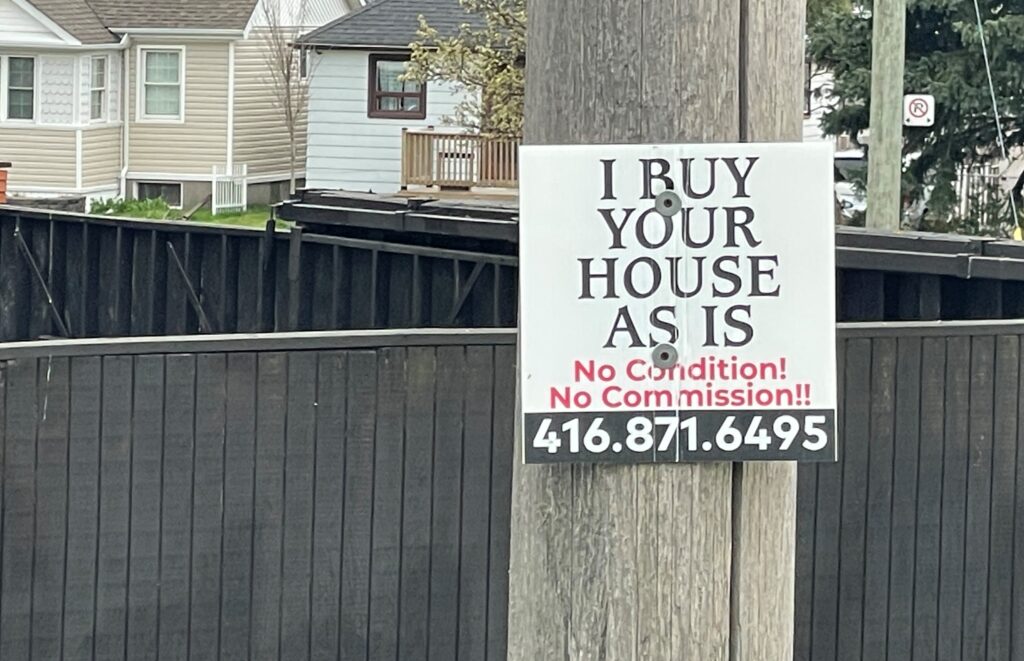Here’s a moment in time, and one that I think I’ve written about before, so stop if you’ve heard this one…
Years ago, I got roped into listing a dozen condos that were owned by the developer, right after the building was registered.
Consider that developers will aim to sell 80% of the units before they ever get a shovel in the ground, both in order to get financing, but also to ensure the project is viable, but also because they want to hold back a few units to sell in 4-5 years when the project is done.
Assuming that the market always goes up, which in 4-5 years, it does, then the units are worth more down the line than they were during the pre-construction phase.
This is why you often see listings for units within a newly-completed condo that are for sale by the actual developer, along with all the ones being flipped by investors.
A colleague and I were asked to sell twelve units in the building and, since there were already about six or seven up for sale, we listed only two and held the others back.
Writing this now – I know I’ve told this story before. So I won’t get into our battle with the developer’s team about staging, marketing, or a complete lack thereof.
But the point I wanted to make was this: after the two units we had listed went unsold for two months, we approached the developer’s VP to talk about a price reduction.
Amazingly, she looked at us with a straight face and said, “No, we’re actually going to raise the prices.”
We were in shock.
It made absolutely zero sense.
When we pressed her for the logic behind the decision, she simply said, “Well, we want more money for them. We need money. So, I think we’ll look for it here.”
Wow, the logic here, or lack thereof, was fascinating.
It was like it took the basic tenets of economics, supply and demand, and any attempt at finding price on an X-Y axis, and threw it all out the window.
In this particular case, raising the prices made zero sense, but I remain amazed at the guts on the developer’s team to enact a pricing strategy that seemed so destined to fail (and eventually did…).
Now, here’s another story, just for fun…
I have mentioned on occasion (or constantly…) that I collected sports cards as a child, and then took it up again as a hobyy a few years ago.
Imagine what it was like to be a 9-year-old or 13-year-old walking in a room, usually a hotel ballroom or the floor of a hockey arena, filled with “dealers,” and trying to conduct business.
We’re not talking about bringing a Snickers bar up to the counter at Beckers and having the man ring it in for $0.79 plus tax. We’re talking about a room full of products at fluctuating prices, all of which are negotiable.
I would like to think that I had my share of wins along with the losses. I was negotiating against grown men, so I take no shame if I overpaid from time to time.
But I remember one instance that stuck with me for the rest of my life. I thought about it in business school and I’ve told this story to my team as far as our real estate discussions go.
I was looking at a 1986-87 Fleer Julius Erving card, priced at $15.
I needed this card for my set.
The dealer I was talking to was a pain in the ass. I saw him every weekend and I never bought from him. He was so verbose and so overbearing that I skipped his table every time, except this weekend, he had this card that I wanted.
It was “priced” at $15 according to the “price guide” that we all considered our Bible at the time, but again, prices were negotiable. In fact, although the price guide told us what cards were worth, we often dealt “below-book,” as it was described, and the dealers that sold below-book did the most business.
I offered him $10 for the card and he scoffed. I waited for his counter-offer, but there was none.
I said, “Alright, I’ll split the difference. I’ll give you $12.50, but I won’t go any higher.”
He then said, “I won’t take anything less than $15,” and I figured that was the end of the discussion.
But then he added, “And this show is ending in twenty minutes as you know.”
I was certainly aware. That’s why I approached him at the end of the show, as I figured this is when many dealers want to clear inventory.
But he added, “When I get home, I’m increasing the prices on all of my 1986-87 Fleer cards. They’ll be higher at the next show. The Julius Erving is going up to $18 because that’s what book value has it at in next month’s edition.”
Going up to $18, eh?
Suddenly $15 seemed like a deal, comparatively speaking.
I paid him $15 and took the card home.
He wasn’t lying though; the next edition of “Beckett Basketball” had the card at $18, for whatever that’s worth.
But the point I’ve held onto over all the years is this: he used the threat of pricing higher to get me to see the value in the existing price.
He beat me in a negotiation and did so by creating leverage where he had none.
He feigned a higher price, whether he was going to increase his asking price or not, and was able to secure a sale.
When we look at how real estate is priced in Toronto, it often seems obvious.
You take a property that’s worth $1,000,000 and list it at $799,000, set an offer date, and voila!
I’ve written entire blogs on how it’s not that simple, and how Agent-A could get $1,100,000 for that property while Agent-B could get $975,000, but that’s not the discussion we’re having today.
In a market that’s somewhat mixed, we often ask ourselves which strategy to use. Do we under-list and holdback or do we list higher and negotiate?
Here’s how I would explain this to a prospective seller:
Option #1:
We list at $799,000 with an offer date. If we are able to obtain our target price, or higher, which in this case is $1,000,000, then we sell the property. If not, then we move on to Plan-B.
Plan-B is to terminate the listing at $799,000 and re-list at $1,049,000, with no offer date.
We build in a negotiating cushion.
The benefits are twofold:
1) By listing at $799,000 initially, we have no ceiling.
2) By listing at $799,000 initially, nobody knows our target price, and when we re-list at $1,049,000, they still don’t really know.
–
Option #2:
We list at $1,049,000 with offers any time.
That’s essentially the strategy.
The drawback is this: we set a price ceiling for our property.
In the first scenario, priced at $799,000, we could get bids of $1,100,000, or more!
In the second scenario, priced at $1,049,000 with offers any time, we’re likely capping our potential sale price, and buyers are going to want to negotiate that price down.
–
Most sellers in this market want to employ the first strategy.
Most listing agents too.
The sellers like this strategy because they feel that it’s proven but also because they like the “sky is the limit” price option.
The listing agents like this strategy because, well, many of them have no clue how to actually price a house or condo in this market. Not only that, many agents only do a couple of sales per year and they crave the perceived power that comes with receiving multiple offers and playing God.
But for experienced agents and savvy sellers, the pricing strategy is crucial.
Once upon a time, we called the “terminate and re-list” action the real estate kiss of death.
It just didn’t work.
It’s like saying, “I’m going to swim out to that rock and back,” only to find that once you got to the rock, you were too tired to swim back. So now, do you stay on the rock, where you don’t want to be, or risk swimming back without the necessary energy to get to shore?
Hmm…
Years ago, the idea of listing at $699,900 with an offer date, failing to sell on offer night, and being forced to re-list again at $829,900 was truly the real estate kiss of death, but somewhere along the line, the action became normalized.
I think we started to see a lot of this in 2017 after the market turned.
Buyers laughed off the idea of “bidding” against other buyers in a tepid market.
Sellers refused to accept that it was July and not March, and laughed off the idea of selling for 15% less.
The result was that we went from seeing 90% of listings in the central core selling on “offer night” to, honestly, I would think about 20% of them selling. It was as though we simply expected properties with offer dates to be re-listed after those failed offer nights.
As the market changes, so does the level of expected success or failure with the dreaded “re-listing at a higher price,” and that means the risk/reward proposition can change as well. Sellers and listing agents need to consider this and plan accordingly.
For years, I was able to claim, “I have never listed a property artificially low, with an offer date, and been forced to re-list at a higher price after a failed offer date,” but that changed in 2017. Since then, I’ve probably done it two or three times, but I can’t remember any specific examples.
Earlier this year, Chris had a listing for a tricky condo townhouse. The buyer paid $975,000 six years ago and it really hadn’t appreciated that much, but worse still was that the market for this type of property wasn’t great.
But the seller wanted the upside of “listing low with an offer date,” just in case the market responded, so they listed for $999,000 with a target of $1,200,000.
To their credit, they did receive two offers on the scheduled offer date, but the highest was $1,050,000 so they kicked them both to the curb.
They re-listed the property for $1,240,000 and despite a lot of tire-kickers making lowball offers, they eventually sold for $1,210,000.
This experience was hardly “the real estate kiss of death,” but that doesn’t mean others can’t be.
I was watching a listing two weeks ago for a semi-detached house, priced at $1,688,800, with an offer date.
Showings were steady. I counted them all (you can track through BrokerBay since showing times are blocked off), and there were about 35-40 in total.
But on offer night, nothing happened.
Zero offers. Imagine that?
Two days later, the property was re-listed for $1,999,900.
So then, is the seller being unreasonable?
Can we merely use the basics of supply and demand to deduce that the property is over-priced?
Logic would dictate that if you are priced at $1,688,800 and you receive zero offers, then you are over-priced. Logic would suggest that there is no interest in your offering at $1,688,800, then there would be even less interest at a higher price.
But the way that we list, price, and sell real estate is often illogical. Not only that, there are reasons why a seemingly under-priced house might not receive offers.
1) Many buyers simply won’t compete.
Depending on the buyer or the time of year, the appetite for competition can waver. Some buyers simply say, “I won’t compete,” and in about 10 1/2 months out of the year, they will have absolutely zero success with that mindset. Others will feel the market moving and when it cools, they might scoff at the idea of competing.
As I write this, a colleague of mine has six offers on her downtown condominium listing, and it’s not a $499,000 unit like you might think. She’s got a million-dollar unit, with an offer date, and has pulled six offers.
But many buyers feel that certain times of the year are slow and shouldn’t necessitate an offer date. Case in point: this week. I’ve often mentioned that the latter two weeks in August are usually among the slowest of the year. Many buyers refuse to compete for properties in a time like this, regardless of how that property is priced.
Receiving zero offers on an under-listed house can often be the result of the buyer pool not wanting to compete at a given time of year, or for a given house, or a particular price point.
2) Many buyers fear the property will bring too much competition.
To say, “I won’t compete, ever,” can be seen as cutting off your nose to spite your face, but there are buyers out there that are happy to compete – to a point.
I’ve walked into properties with buyers who immediately felt, “This is going to sell out of our price range,” and who talked themselves out of even considering it! In a couple of rare cases, I’ve received panicked calls from the listing agent who says, “Oh my God, we only have one offer! Can you bring your clients?”
But what happens when you, as a buyer, go from, “This property is going to get twenty offers and sell out of our price range,” suddenly to, “This property only has one offer”?
Human nature is to conclude, “There’s something wrong with the house.”
Receiving zero offers on an under-listed house can often be the result of the buyer pool thinking that the property is too good, and walking away.
3) Many buyers want to see what the property is re-listed for
Often buyers and buyer agents are so sure that a certain property won’t sell that they simply wait for the terminate-and-re-list a day or two later.
That’s playing with fire, right?
A $1,200,000 house is listed for $999,000, and you decide to wait?
Sure, if you’re right, it could pay off.
After all, you have no idea what the seller’s target price is. Maybe it’s more than $1,200,000, but maybe they only expected $1,150,000. If you take the risk that the property doesn’t sell on offer night, and it proves to be the case, then you get to see what the seller re-lists for, and maybe, just maybe, you have leverage.
Leverage means bargaining power, and in a case like this, the tables turn.
Receiving zero offers on an under-listed house can often be the result of a savvy, calculated buyer pool who strategically wants to see if the house sells, or not, and what it’s re-listed for.
As for this house that was listed for $1,688,800 and now sits at $1,999,900, well, I think the seller is playing games here too.
I believe this is a $1,900,000 house. It could be worth less or rather could sell for less, but I think the seller is smart enough to understand the idea of a “price ceiling.” Any seller who has lost leverage, ie. the “under-listing” strategy that fails, is going to want some leverage back.
That’s why the “re-list at a higher price” strategy will often actually come in the form of a “re-list at a much higher price” strategy.
This is what I mean by “building in the negotiating cushion.”
If re-listing higher once was “the real estate kiss of death,” then it doesn’t really matter how much higher you re-list, right? Jack up the price a bit, build in that negotiating cushion, and maintain some leverage.
It reminds me of the card dealer who told me he was going to raise the price of the $15 card to $18 for the next card show. He was just building in that negotiating cushion. It was like he changed the price sticker right there on the spot, then sold me on a reason why I should pay the full price.
As crazy as it is to take cues on Toronto real estate in 2023 from the purchase of a basketball trading card in 1993, pricing games are pricing games, no matter where they’re found.
Re-listing a house or condo at a higher price after a failed offer date isn’t the death knell that it once was, but buyers and sellers can come out ahead or behind depending on how they play their cards…
































Marina
at 8:44 am
I’ve often wondered what would happen to real estate strategies if the rules for almost all other products applied to real estate as well – you HAVE to sell if someone offers the listed price. Would you then have the massive over list strategy, so there’s still no ceiling but from the other side? Would there be fewer bubbles? Would the buying window shorten since anyone can offer anytime?
It’s just a thought exercise. The real way the real estate market works is so unfriendly to new buyers. Listed price has little to do with anything. If you don’t have a good agent, you are basically screwed. But if you are a first time buyer, how would you know anyway? The agent has no fiduciary duty. It’s bananas. And don’t even get me started on what developers get away with in precon sales.
JL
at 9:42 am
Agreed. It’s been talked about here often over the past number of years that the current “list price” is essentially meaningless, but too many new buyers still (and with some justification) get fooled into thinking that it could be the potential sale price. I think David referring to it at the end as “pricing games” sums it up rather well, but its hard to argue that approach makes the system more efficient or buyer friendly.
hoob
at 12:47 pm
Why do you think those rules apply to almost all other products? They don’t. By convention that’s often how it is, but there’s no “rules” about it. Both ways, everything is negotiable (though of course many contexts will refuse to negotiate out of preference for consistency.)
Bryan
at 1:31 pm
This is not true. These rules absolutely do apply to any product in Canada that has an advertised or posted price. The competition act expressly defines not accepting a price you posted as false advertising, and outlaws it with a maximum fine of $750,000 for an individual (plus up to a year in jail if found to be criminally reckless) and $10M for a corporation. Pretty serious stuff.
To answer (kinda) Marina’s question (as David has often pointed out), we basically just ignore advertising law in real estate. I don’t really think it makes sense, but generally the reasons given for that are a) there are many more terms in an agreement of purchase and sale than just price, so it is impossible to police false advertising (a person could easily say, “their offer included my fridge and I wanted to keep it” etc.) and b) there are often multiple offers for a single property and there needs to be an objective way to decide who gets to buy it. If two people offer list price or higher who do you sell it to? Convention dictates it is the person who offers more, and that shouldn’t mean you get sued by the other bidders for false advertising.
I have often mused that the quickest way to “solve” this “problem” would be to change the system so that in order to post on MLS, a seller would need to write and sign an entire APS, rather than just posting a desired price (with a waiver that says “this agreement is null and void if there are multiple offers by XYZ date”). That way, if just one person accepts the seller’s terms, the property is sold to them for list price!… but if multiple people want it then everything would work like it does now.
R
at 4:45 pm
If multiple people offer the buying price, first one gets it. How’s it any different than buying anything in a store or online with limited quantities? You don’t see a bidding war on the last T shirt left at the gap.
The problem is indeed that agents have no interest in the clients best interest. The opposite in fact. The higher the price the more they make!
Bryan
at 12:37 pm
I think an auction is a better parallel than the Gap. Stores have an inherent advantage in that they sell many identical (or basically identical) items over a long period of time, and thus know exactly how much it should be sold for. For complicated or one of a kind type items, auctions are often a more efficient and more fair way to sell. The “accept the first offer” is likely to create a world where thousands of people are trying to refresh their mls pages the second they get updated to get the jump on everyone else. Sucks for you if you work the night shift I guess! An auction on the other hand allows everyone to bring their offers and compete fair and square at a predetermined date and time. People can view the property/item, get inspections, appraisals, financing etc. At auctions outside of real estate however, the seller is forced to sell the item to the highest bidder as long as the bidding reaches some minimum number. The absence of that in real estate is what I see as the main problem here. There is just no risk or downside to listing a home for $1, and there really should be. A “minimum acceptable bid” provides that risk and would almost certainly stop this pricing games nonsense. As with the “first offer wins” idea though, this would likely cause agents to comically over-list the property so people still end up in bidding wars with no idea what price they should offer.
Ed
at 9:35 am
What’s the card worth today?
David Fleming
at 4:24 pm
@ Ed
That’s tough to answer.
Back in the day, a card was a card.
Today, every card is graded by a professional grading company (usually PSA) and encased in plastic.
According to the population report, there are 1,080 graded examples of this card.
PSA-8’s are selling for $70.
PSA-9’s are selling for $180.
PSA-10’s are selling for $1,500.
It costs $20 to grade the card, so my $15 in 1994 plus $20 to grade today, and maybe I get a PSA-7 or a PSA-8.
Not the best investment! 🙂
PJ
at 7:24 am
I find a measure of interest in your blogs, though I do have a concern about the criticisms you direct towards fellow realtors. Being a family-oriented person and a part-time agent venturing into the field, I’m currently involved in a modest number of deals each year. I’m relishing the learning process, aiding people, nurturing connections, and I’m eyeing the transition to a full-time agent when the time aligns. As we recognize, timing holds paramount importance.
It might be worth considering that some of the agents you criticize for their infrequent transactions could potentially become collaborators down the line. They might be the ones listing the perfect home your client has been seeking or have a buyer for your long-standing listing. In that scenario, how would your perception change? Would they transform into the godlike figures you once mentioned? Casting negative aspersions on fellow realtors doesn’t contribute positively to an industry that already contends with its share of negativity.
The act of judging another doesn’t just shape our view of them, but it fundamentally shapes our own character.
QuietBard
at 8:58 pm
You calling someone else verbose is like Usain bolt calling someone else fast. Just strange to see 🙂